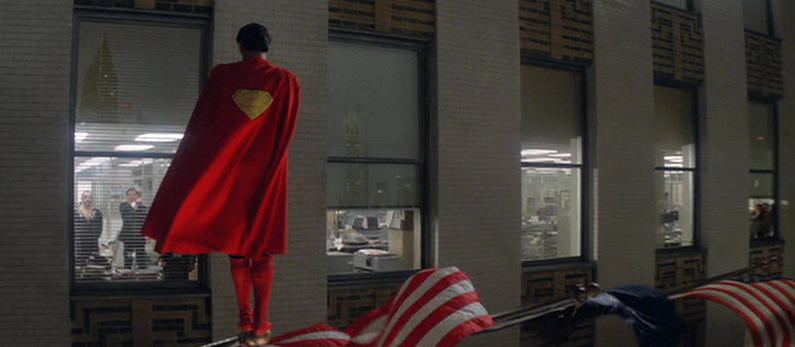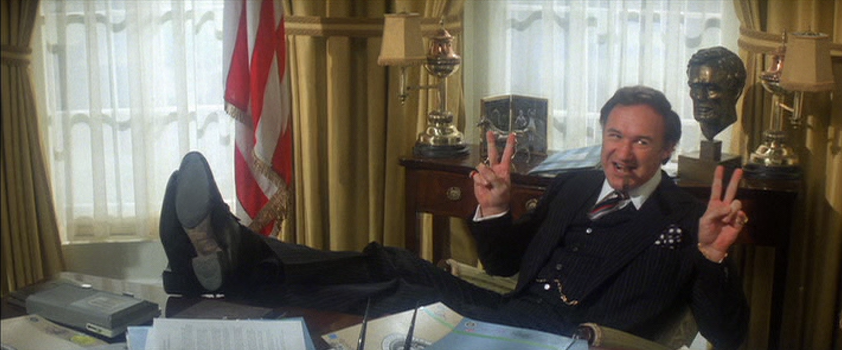

“It is extremely likely you are merely a fool. Like father, like son.”
A quarter of a century after Richard Lester took over the directorial duties of Superman II the original footage shot by Richard Donner was pulled out of the dustbins of history and reconstructed into The Richard Donner Cut. The history of the franchise is kind of a crapshoot, with creative differences, egos, and budget cuts hamstringing the series as progressively worse and hammier installments finally drove it into the ground with The Quest for Peace. Interest in Donner’s version of the film increased during restoration efforts for the original Superman, and the dream became a possibility when footage of Marlon Brando1 was discovered while creating Superman Returns (2006). Viewed without historical knowledge of the franchise, it can be an uneven experience, but it holds together much more cohesively than the theatrical release.
Donner had originally been hired to direct the first two films in the series before his dismissal midway through the production of the second. In order for Lester to be credited as sole director, a large portion of Donner’s footage was discarded and the scenes were reshot by Lester. Because of this, Donner’s reconstructed version is like watching an entirely different film rather than an “alternate cut.” Though it still features some of Lester’s footage, as well as several digitally created scenes and Christopher Reeve’s screen test as Clark Kent, the story comes across much better than Lester’s finished product. It will remain unclear who is to blame for the decline in quality from the first film to the second (though we have evidence—in the form of Superman III—that Lester was not the right fit for a Superman adaptation), but it is obvious that Donner’s vision was superior and it is a shame that the film wasn’t completed on his terms.

Most of the head-scratching moments present in the original release have been scrubbed from this version. The plot involving the escaped Kryptonians is integrated better and General Zod (Terence Stamp) and his team are much more menacing than they were in the original. The general banter—especially between Clark and Lois as well as all of Gene Hackman’s lines as Lex Luthor—is much richer, funnier, and more intelligent.2 Though the plot plays out largely the same there are several moments that were completely different from Lester’s version. The most memorable instance is how Lois (Margot Kidder) discovers that Clark (Christopher Reeve) is Superman. In both films, she suspects it, and puts Clark to the test by risking her life. And in both films, Clark rescues her without revealing that he is Superman. In the original, she finally discovers the truth when he burns his hand but his flesh remains undamaged. In The Donner Cut, Lois fires a blank round from a revolver at Clark’s chest, tricking him into thinking he had just absorbed a bullet. The team used footage from a screen test of Christopher Reeve auditioning for the role, which is noticeable because his hair style and glasses are different from shot to shot, but the dramatic improvement is undeniable.
The commentary track with Donner and creative consultant Tom Mankiewicz is very informative and worth perusing if you’re interested in that sort of thing. The ending of Donner’s version, involving Superman reversing time, appears to rip off the ending of the first film. But that feat was originally intended to be the ending of the second film. However, since the special features were, at the time, visually compelling, state of the art effects, the producers stuck their noses in and had the plot device moved up to the climax of the first film.

Much of the credit for the film’s release is due to editor Michael Tau, who initially showed interest in helming the project when he was restoring the first film in the early 2000s. Likewise, credit is due to fans of the franchise who applied enough to the studio to get the project off the ground. Similarly, fans of Zack Snyder were rewarded with the (upcoming, as of August 2020) Zack Snyder’s Justice League; the original Justice League had been taken over by Joss Whedon following the death of Zack Snyder’s daughter, and many fans believed that the finished film did not convey the original vision of Zach Snyder.
If you can look past the warts inherent in trying to stitch together a film from a partially finished project thirty years later, it certainly stands up against Superman in terms of quality. From this historical view, Reeve’s screen test is almost endearing rather than a hindrance. Released two years after Reeve’s death, the film is dedicated to his memory. I wouldn’t call any of the Superman films classics of cinema—of their specific genre, maybe—but I’m glad that the Donner cut was finally given the green light. It is a joy to see the alternate, superior scenes that had been cut in favor of Lester’s reshoots, and to see these unburied artifacts pieced together into an entire feature length film.
1. Brando’s role was cut in the original version due to a dispute over compensation for the first film.
2. One of the main criticisms of Lester’s film was that its comedy undercut the semi-serious tone that Donner had set with Superman. But, to me, Donner’s version is funnier. It’s just a different kind of comedy. In Lester’s version, we had a lot of physical comedy, such as a man losing his toupee when the Kryptonians created a windstorm. In Donner’s version, the dialogue is infused with humor, which works much better.